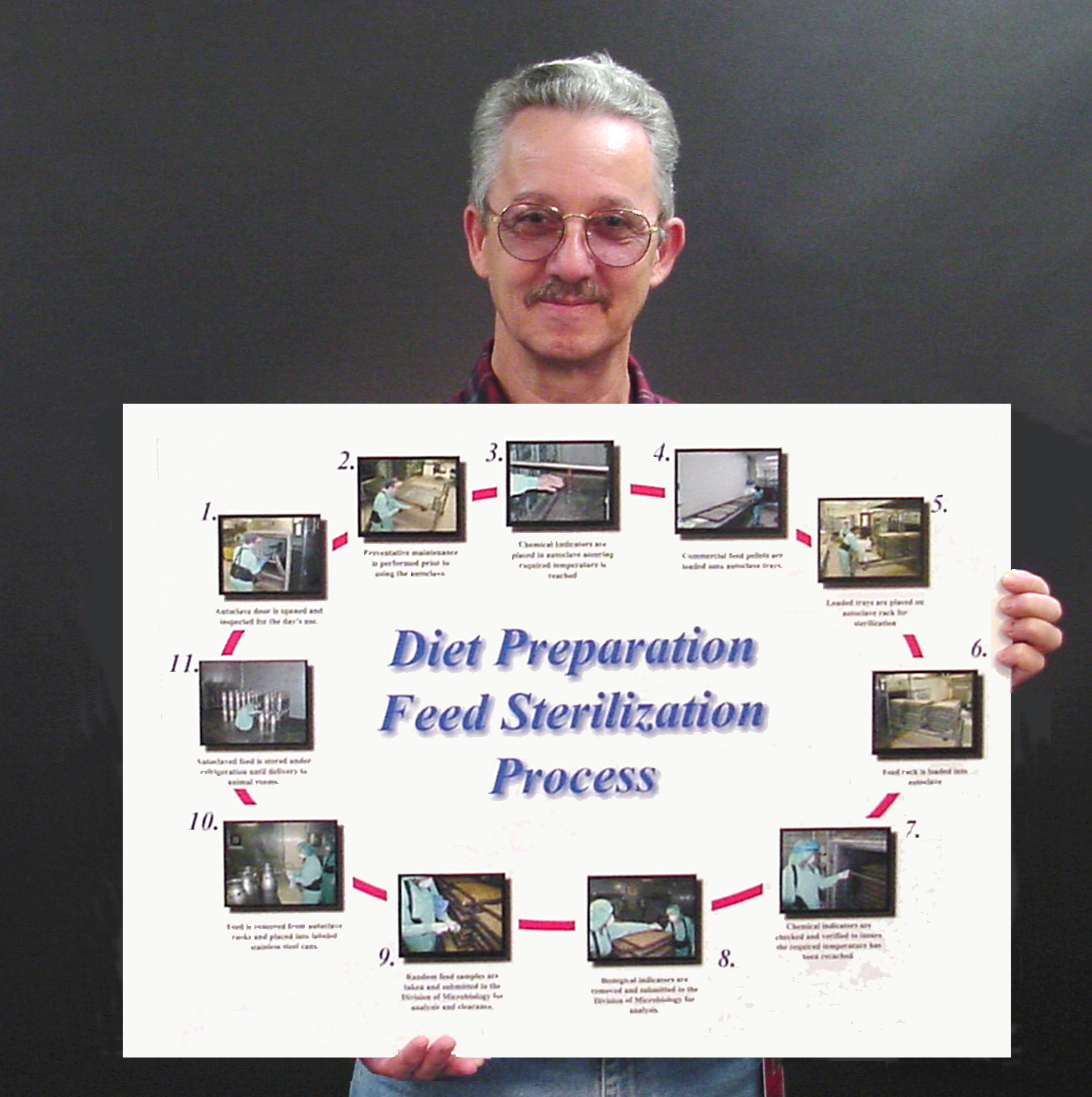October 2003, Volume 2, Issue
1
National Guard
Tours NCTR
By Billie Minton
On September 17 and 18, the NCTR and Arkansas Regional Laboratories (ARL) welcomed
the 3rd Platoon Chemical Site Defensive Force (CSDF) of the Oklahoma
Army National Guard for a tour to learn about the FDA and its mission to
protect our nation’s health. On the walking tour, NCTR investigators talked to
them about the history of NCTR, primate studies, phototoxicology research, and
Fresh Quality Indicator (FQI) technology. The Acting Director of the ARL completed
the tour with a walk-through of the ARL microbiological and chemistry mass
spectrometry operations. The CSDF was activated in May 2003 and assigned to the
Pine Bluff Arsenal for one year to carry out Homeland Security
responsibilities.
Arkansas Branch of AALAS Meets at NCTR
The Arkansas Branch of AALAS (American Association for
Laboratory Animal Science) met July 26 at NCTR. The Arkansas branch became affiliated with the
National organization in 1970 with a purpose
to “…act as an information and education source concerning the responsible care
and use of laboratory animals.” Membership is comprised of staff from local universities, commercial research
laboratories, and the NCTR. Dr. Ann Turner, the Executive Director, and Dr. Chip
Price, the Vice-President elect, represented the National AALAS
organization. Dr. Turner updated the seventy-six attendees on “AALAS at Work.”
Martin Nichols, the President of the Arkansas branch, hosted an awards presentation in which NCTR staff received the
“Technician of the Year Award,” the “Harvey Kalbach Award” for professional excellence in the
field of laboratory animal management, and the 1st, 2nd, and 3rd place
poster awards.

William Braswell, a NCTR diet preparation technician, displays his prize winning poster.
Photo/D.Tucker
Willard’s Dog Days of Summer Race
By Fred Beland, Ph.D.
For the eighth consecutive year, NCTR has served as host to Willard’s Dog Days of
Summer Criterium Series, a set of bicycle races held weekly during July and
August. More than 75 riders, including riders from Arkansas, Tennessee, Texas, and Kansas,
participated in two races each evening. The riders considered NCTR an ideal
location due to its restricted car and pedestrian traffic, and the smooth road
surface that allowed speeds in excess of 40 mph to be obtained. Donnie Van
Patter, who rides for a local team (CARVE), was the overall winner, while his
teammate Greg Eberdt was second. Peter Beland, who is sponsored by a
Colorado-based team (Schwab Cycles), was third. In the preliminary event, Jason
Polanski, who races for the California-based team Ranchos, was first and Meghan
Specht was the overall women’s winner.
NCTR Scientist Named Distinguished Alumni
Dr. Ralph L. Kodell, Director of NCTR’s Division of Biometry and Risk
Assessment, was recently inducted into the Academy of Distinguished Graduates
of Texas A&M University’s College of Science in recognition of his outstanding leadership in
mathematics and the sciences.
Dr. Kodell was recognized as a leading researcher on statistical
methods for toxicology and as an expert in using statistics to assess health
risks. He has developed statistical testing procedures used in the
pharmaceutical industry for carcinogenicity assessment, and statistical
estimation procedures that provide the basis for cancer risk estimates used by
the FDA and EPA.

Dr. Ralph Kodell, distinguished
Texas A&M Alumni. Photo/D.Tucker
Recent Publications
NCTR conducts research designed to protect the public’s health. Results from some of these research
projects have recently been accepted for publication in nationally recognized
scientific journals.
Regulatory Research Perspectives: Impact on Public Health,an on-line newsletter that
provides a vehicle for FDA scientists to communicate important scientific
information, is available at
http://www.fda.gov/nctr/science/journals/Default.htm.
- Allred, C.D., Dietary Genistein
Results in Larger MNU-induced, Estrogen-dependent Mammary Tumors Following
Ovariectomy of Sprague-Dawley Rats, Carcinogenesis
- Baldwin, R., Effect of Methylphenidate on Time Perception in Children with ADHD, Journal of Experimental and Clinical
Psychopharmacology
- Beger, R., Combining NMR Spectral Information with Associated Structural Features to Form Computationally
Non-Intensive, Rugged and Objective Models of Biological Activity, In: DISCOVERY HANDBOOK:
Pharmaceutical Development and Research Handbook
- Beger, R., Structure and Dynamics of Thioguanine-Modified Duplex DNA Containing a Single Central Thioguanine Modification, Journal of Biological Chemistry
- Bowyer, J.F., Selective Changes in Gene Expression in Cortical Regions Sensitive to Amphetamine Neurotoxicity, NeuroToxicology
- Chelonis, J.J., The Effects of Prenatal Cocaine Exposure on Reversal Learning Using a Simple Visual Discrimination Task, Neurotoxicology
and Teratology
- Chen, J.J., How Many of the Rejected Hypotheses are False?, Bulletin of the International Chinese Statistical
Association
- Chou, M.W., Riddelliine N-oxide is a Phytochemical and Mammalian Metabolite with Genotoxic and Activity that is
Comparable to the Parent Pyrrolizidine Alkaloid, Chem. Res. Toxicology
- Chou, M.W., Identification of DNA
Adducts Derived from Riddelliine, a Carcinogenic Pyrrolizidine Alkaloid, Chem. Res. Toxicology
- Cisneros, F.J., Transplacental Exposure to the DNA
Methylating Agent, 5-AZA-CdR, Affects the Sexual Behavior of CD-1 Male Mice, NeuroToxicology
- Cui, Y., In Vitro Metabolism
of Hyperforin in Rat Liver Microsomal System, Drug Metabolism Disposition
- Ferguson, S.A., Developmental Treatment with Difluoromethylornithine
(DFMO) has Few Effects on Behavior or Body Weight in Sprague-Dawley Rats, Journal Neurotoxicology and Teratology
- Ferguson, S.A., In vivo Basal and Amphetamine-induced Striatal
Dopamine Release is Similar in the Spontaneously Hypertensive, Wistar-Kyoto
and Sprague-Dawley Male Rats, Physiology and Behavior
- Hashemi, R.R., Grid Based Analysis Approach for Learning from Sparse Data, 1st ACIS International Conference on
Software Engineering Research and Applications (2003)
- He, Y., Role of Nitric Oxide in
Rotenone-induced Nigro-striatal Injury, Journal of Neurochemistry
- Hotchkiss, C.E., Effect of Pair-housing on Operant Behavior Task Performance by Rhesus Monkeys, Contemporary Topics in
Laboratory Animal Science
- Kim, Y., Sorption and Clay-catalyzed Degradation of Erythromycin A on Homoionic clays, Journal of Environmental
Quality
- Kim, Y., Sorption and Degradation of Erythromycin A in Aquaculture Sediments, Journal of Environmental Pollution
- Leakey, Body Weight Considerations in the B6C3F1 Mouse and the Use of Dietary Control to Standardize Background Tumor
Incidence in Chronic Bioassays, Toxicology and Applied Pharmacology
- Leakey, J.E., Dietary Controlled Carcinogenicity Study of Chloral Hydrate in Male B6C3F1 Mice, Toxicology and Applied
Pharmacology
- Leakey, J.E., Toxicokinetics of Chloral Hydrate in Ad libitum-fed, Dietary-controlled and Calorically
Restricted Male B6C3F1 Mice Following Short-Term Exposure Using Idealized Body Weight Curves that are Normalized by Modulation of
Caloric Intake, Toxicology and Applied Pharmacology
- Lopachin, R.M., Application of Proteomics to the Study of Molecular Mechanisms in Neurotoxicology, NeuroToxicology
- Malling, H., Three origins of am3 Revertants in Transgenic Cell Culture, Environmental and Molecular Mutagenesis
- Middaugh, L.D., Neurobehavioral Assessment: A Survey of Use and Value in Safety Assessment Studies, Toxicological Sciences
- Molefe, D., Tests for Effects on Tumor Frequency and Latency in Multiple Dosing Photococarcinogenicity Experiments, Journal
of Statistical Planning and Inference
- Moon, H., Bootstrap Adjustment of Asymptotic Normal Tests for Animal Carcinogenicity
Data, Proceedings
of the Biometrics Section, American Statistical Association
- Nawaz, M.S., Detection of galE gene by Polymerase Chain Reaction in Campylobacters, Molecular Cellular Probes
- Rafii, F., Mechanism of Metronidazole-resistance in Isolates of Nitroreductase-producing Enterococcus
gallinarum and E. casseliflavus from the Human Intestinal Tract, FEMS Microbiology Letters
- Scallet, A.C., Electroencephalographic, Behavioral, and c-fos Responses to Acute Domoic Acid
Exposure, Neurotoxicology
and Teratology
- Seng, J.E., Toxicokinetics of Chloral Hydrate in Ad Libitum-Fed, Dietary-Controlled and Calorically
Restricted Male B6C3F1 Mice Following Short-Term Exposure, Toxicology and Applied
Pharmacology
- Tsai, C., Estimation of False Discovery Rates in Multiple Testing: Application to Gene Microarray Data, Biometrics
- Turesky, R., Identification of Aminobiphenyl Derivatives in Commercial Hair Dyes, Chemical Research in
Toxicology
- Williams, L.D., LC/MS Determination of the Metabolism and Disposition of the Antiretroviral Nucleoside Analogs
Zidovudine and Lamivudine in C57BL/6N Mice, Journal of Chromatography B.
On-Line Research Information
Regulatory Research Perspectives: Impact on Public Health, an
on-line journal that provides a vehicle for FDA scientists to communicate important
scientific information, and NCTR's FY 2002-2003 Research Accomplishments and Plans
are available from NCTR’s web site at
http://www.fda.gov/nctr/science/science.htm.
Contact Information
The NCTR Quarter Page is published four times a year by the Division
of Planning at the National Center for Toxicological Research. For more information about
NCTR contact Dr. Dan Casciano, NCTR Director, at dcasciano@nctr.fda.gov or [870] 543-7517.
|